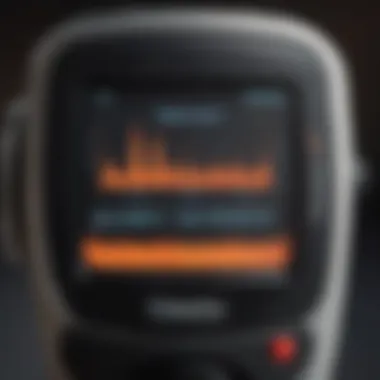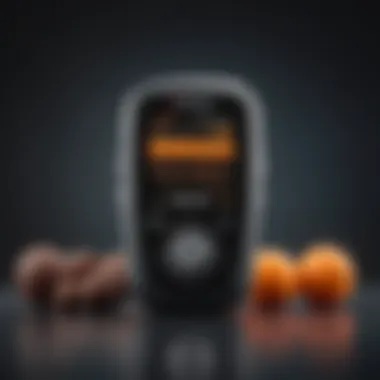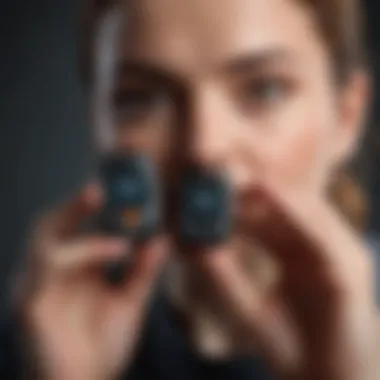Accurate Oximeters: A Comprehensive Evaluation Guide


Intro
The significance of accurately measuring blood oxygen saturation cannot be overstated. The oximeter serves as a critical tool in both clinical and home settings, providing essential data that impacts a patient's health management. With an increasing number of devices available, distinguishing the most accurate oximeter has become paramount.
This article not only takes a close look at the features that determine an oximeter's accuracy but also guides readers through the various types of oximeters on the market. As we delve into this analysis, we will explore common misconceptions and highlight the relevance of having a precise device for monitoring oxygen levels. The insights and recommendations provided here aim to equip health professionals and wellness coaches with the knowledge necessary to make informed decisions.
Key Benefits
In understanding the core advantages of utilizing a reliable oximeter, it becomes evident how essential these devices are for maintaining physical health, as well as enhancing mental well-being.
Physical Health Benefits
A precise oximeter allows for real-time monitoring of blood oxygen saturation. This capability is invaluable for individuals with respiratory conditions, like chronic obstructive pulmonary disease (COPD) or asthma. Monitoring can help in promptly identifying dips in oxygen levels, prompting timely medical intervention.
Accurate measurements also play a crucial role in managing conditions such as sleep apnea. Individuals using an oximeter during the night can better understand their sleep patterns and oxygen levels, thus improving their overall health. Furthermore, athletes can benefit from using oximeters to gauge their oxygen saturation during training, leading to more effective performance optimization.
Mental Well-being Enhancements
The psychological aspect of health monitoring is often overlooked. Knowing that one is using an accurate oximeter can provide greater peace of mind. The anxiety surrounding potential health issues often diminishes when individuals have access to reliable data about their physical condition. For many, the certainty of correct readings fosters a sense of control over their health, which directly correlates to improved mental well-being.
"Accurate health monitoring can alleviate stress, where informed choices lead to better mental and physical outcomes."
Establishing a habit of regular monitoring can enhance confidence in managing one's health. This habitual practice supports mindfulness, contributing positively to mental health. Therefore, the psychological benefits associated with using a precise device extend beyond mere data acquisition; they encompass an overall improvement in health-related quality of life.
Practical Tips
Navigating the oximeter market requires an understanding of what features matter most. Here are some practical suggestions for selecting the right device:
- Assess Features: Look for advanced features such as pulse rate measurement, data tracking capabilities, and connectivity options.
- Consider User-Friendliness: Choose a model that is intuitive and easy to operate, particularly for non-tech-savvy individuals.
- Check for FDA Approval: Ensure the device is cleared by the Food and Drug Administration, signaling that the manufacturer meets specific safety standards.
- Read Reviews and Comparisons: Websites like Reddit and medical forums provide genuine user experiences and can help you make an informed choice.
- Consult with Professionals: Health care providers can offer recommendations based on your specific needs, be it for at-home use or professional settings.
In summary, selecting the most accurate oximeter involves understanding both the physical benefits it provides and the psychological comfort it can offer. This guide aims to empower readers with knowledge that transcends mere device selection and fosters overall health management.
Understanding Pulse Oximetry
Pulse oximetry plays a critical role in both clinical and personal health monitoring. It allows for non-invasive assessment of blood oxygen saturation levels. This technology provides clear insights into a patient’s respiratory function and helps in determining their overall health status. Understanding how pulse oximeters work and their significance in various scenarios is essential for health professionals, wellness coaches, nutritionists, fitness trainers, and mindfulness instructors alike.
Definition and Functionality
Pulse oximetry is a method used to measure the oxygen saturation of hemoglobin in the bloodstream. It typically involves a device called a pulse oximeter, which uses light waves to assess how much oxygen is in the blood. The primary functionality of this equipment is to provide rapid readings that are crucial for decision-making in both emergency and routine situations.
The basic components of a pulse oximeter include a light-emitting diode (LED) and a photodetector. The LED emits light at two different wavelengths: one is red, and the other is infrared. When the device is placed on a thin part of the body, like a fingertip or earlobe, the light passes through the tissue. As oxygenated and deoxygenated hemoglobin absorb light differently, the device calculates the ratio of absorbed light to provide a percentage of oxygen saturation. Generally, readings above 95% are considered normal, while lower values might indicate a need for medical attention.
How Pulse Oximeters Work
Pulse oximeters operate on the principle of light absorption by oxygenated and deoxygenated blood. When the LED emits light, it passes through the skin and absorbs at different rates based on the nature of the hemoglobin in the blood.
- Measurement Process: The pulse oximeter can measure the changes in light absorption as blood pulses through the capillaries. This is what allows it to take readings in real-time.
- Data Interpretation: The device processes the light absorption data and calculates the blood oxygen saturation level, commonly referred to as SpO2. It is important to note that the devices provide readings based on the algorithm configured into them, which means accuracy can vary.
- Environmental Considerations: External factors such as nail polish, skin pigmentation, and ambient light can affect the performance of the pulse oximeter. Understanding these influences can help in interpreting the readings correctly and achieving optimal usage.
"A pulse oximeter is a vital tool in both home and clinical settings, providing necessary information about a person's respiratory status, which can be life-saving in many scenarios."
The Importance of Accuracy in Oximeters
Accuracy in oximeters is crucial for a variety of reasons, particularly in clinical and home settings where monitoring blood oxygen levels is essential. An accurate reading can directly influence patient care decisions. Therefore, understanding the implications of oximeter accuracy is not just beneficial—it is necessary for ensuring optimal health outcomes.
Accurate oximeter readings enable healthcare professionals to make informed decisions about patient treatment. For instance, if a patient's oxygen saturation is incorrectly reported as adequate, the healthcare team may delay interventions. Such delays can lead to serious health complications. Conversely, a false low reading could result in unnecessary treatments and anxiety. Thus, the precision of measurements is paramount in avoiding misdiagnosis and ensuring appropriate clinical responses.
In the realm of home monitoring, the stakes are equally high. People using oximeters at home need reliable data to manage their respiratory conditions effectively. If individuals with chronic obstructive pulmonary disease (COPD) or other lung diseases rely on inaccurate readings, they may neglect necessary medical care or misjudge their health status. This can further exacerbate their health issues, leading to preventable hospitalizations.
Clinical Implications of Accurate Readings


Accurate readings from pulse oximeters have significant clinical implications. They serve as vital indicators in patient assessment, especially in critical care units where every second counts. In conditions such as pneumonia or pulmonary embolism, an oximeter reading can signal the need for immediate intervention.
Inaccuracies can lead to inappropriate use of supplemental oxygen, which could either harm a patient or leave them without necessary care.
- Critical Monitoring: Oximeters are often the first line of monitoring for patients in emergency situations. Thus, accurate devices can mean the difference between life and death.
- Assessment during Surgery: During surgical procedures, monitoring oxygen levels can reveal underlying complications quickly. Deviations from expected levels can prompt timely interventions.
- Effective Management of Chronic Conditions: For chronic patients, consistent accuracy helps in tracking disease progression and response to therapy.
"Accurate oximeter readings are essential for timely medical interventions and optimal management of patients' respiratory health."
Impact on Home Monitoring
Home monitoring using oximeters is becoming increasingly popular, especially among individuals with chronic illnesses. Here, accuracy plays a pivotal role. Many patients rely on home oximeters to make daily decisions regarding their health. Therefore, understanding how accurate readings support self-management can greatly enhance patient autonomy and safety.
The convenience of at-home monitoring allows patients to track their oxygen levels regularly. This practice:
- Empowers Patients: It promotes empowerment by enabling individuals to take an active role in their health management. Knowing they have reliable tools reduces anxiety.
- Facilitates Early Intervention: Regular checks can lead to early detection of deterioration in health status. If patients notice a drop in their oxygen levels, they can seek medical advice sooner.
- Enhances Communication with Healthcare Providers: Accurate readings can be communicated effectively to healthcare professionals, aiding in telehealth consultations and virtual monitoring.
The impact of accuracy is expansive when it comes to home monitoring and underscores how essential these devices have become in everyday health management.
Types of Oximeters Available
Understanding the different types of oximeters is crucial for determining the right one for individual use. The availability of various models reflects the diverse needs of users, from medical professionals to home users. Each type of oximeter has distinct features, benefits, and limitations. By exploring these different options, one can make informed decisions based on accuracy, convenience, and specific use cases. This section examines four primary categories of oximeters and allows readers to evaluate which model aligns best with their requirements.
Finger Pulse Oximeters
Finger pulse oximeters are perhaps the most recognized type. These small devices are typically used in clinical settings and for personal monitoring. They work by clamping onto the fingertip, using light absorption to measure the oxygen saturation of hemoglobin in the blood.
Advantages of finger pulse oximeters include:
- Portability, easily fitting in the pocket.
- Immediate readings, often displaying results within seconds.
- Non-invasive and simple to use, requiring minimal user intervention.
Considerations include:
- Potential inaccuracies when used on patients with darker skin tones.
- Reduced accuracy if there is poor circulation or movement during the reading.
Wrist Pulse Oximeters
Wrist pulse oximeters are a practical alternative, designed for continuous monitoring. They are worn like a watch, providing ongoing assessments of blood oxygen levels. This can be especially useful for individuals with chronic respiratory conditions.
Benefits of wrist pulse oximeters:
- Real-time monitoring over extended periods.
- User-friendly interface, suitable for both medical professionals and average users.
- The convenience of being less intrusive than finger models, promoting compliance in long-term use.
However, there are limitations:
- Typically larger than finger oximeters, thus less portable.
- Often more expensive, which can be a consideration for those on a budget.
Handheld Pulse Oximeters
Handheld pulse oximeters offer versatility and are used frequently in home health care settings. These devices can provide accurate readings for multiple patients, making them ideal for use in clinics or hospitals. They usually feature larger screens for easy reading.
Key features include:
- Ability to take precise measurements easily.
- Often include additional features like data storage for tracking trends over time.
Bear in mind:
- They can be more cumbersome than finger devices, requiring a dedicated space for use.
- They may require calibration, which can be a barrier for some users.
Wearable Oximeters


Wearable oximeters are among the latest advancements in monitoring technology. These devices can be integrated into fitness trackers or smartwatches. This modern approach allows for continuous monitoring and is particularly appealing to fitness enthusiasts and health-conscious individuals.
Advantages include:
- Seamless integration with lifestyle, allowing for ongoing tracking of health metrics.
- Collect data over time, resulting in valuable insights for both users and health providers.
Considerations for wearable devices include:
- Accuracy can vary depending on the brand and model.
- Battery life may impose limitations on continuous use.
In summary, understanding the range of oximeters available empowers users to choose a model that fit their needs, enhancing the accuracy of blood oxygen level monitoring. Each type comes with a specific set of features, benefits, and drawbacks that must be assessed carefully by the potential user.
Evaluating Oximeter Accuracy
Evaluating the accuracy of pulse oximeters is essential for ensuring reliable blood oxygen saturation measurements. As these tools become increasingly common in both clinical and home settings, understanding the factors that influence their accuracy is vital. An inaccurate reading can lead to misdiagnosis or inappropriate treatment, making this topic profoundly significant. In this section, we will explore the key elements affecting accuracy and perform a comparative analysis of major oximeter models to guide readers in selecting the most reliable device.
Key Factors Influencing Accuracy
Calibration Standards
Calibration standards play a crucial role in ensuring that oximeters provide accurate readings. Proper calibration aligns the device's output with established reference points, which is essential for reliable measurements. A key characteristic of calibration standards is their periodic requirement. Medical devices undergo routine calibrations to maintain their accuracy over time. This makes calibration a beneficial aspect of oximeter use.
One unique feature of calibration standards is their adherence to protocols defined by health authorities, like the FDA. This ensures that devices meet a minimum threshold of accuracy. However, the disadvantage is that not all oximeters maintain their calibration equally. Users may need to verify the calibration status regularly, particularly for home-use devices.
Sensor Technology
Sensor technology is another pivotal factor influencing the accuracy of pulse oximeters. Modern oximeters use advanced photoelectric sensors to detect blood oxygen levels through the skin. This technology allows for quick and non-invasive assessments. The main advantage of this kind of sensor is its ability to provide real-time data, which is crucial in clinical situations.
A unique feature of contemporary sensor technology is its capacity to adapt to different skin tones, which helps reduce discrepancies in readings. However, some models may still struggle with accuracy under certain conditions, such as low perfusion or motion. Thus, understanding sensor technology can inform which models provide more consistent readings.
User Technique
User technique significantly contributes to the accuracy of pulse oximetry readings. Proper placement and use of the device are necessary to ensure valid results. A key characteristic of user technique is the need for stability during the reading process. Movements during measurement can lead to erroneous outputs, highlighting the importance of correct usage.
One unique aspect of user technique is the effect of peripheral factors, such as temperature and blood flow. For instance, cold fingers can yield misleading readings. Educating users on effective techniques improves overall measurement accuracy, but it may be challenging to ensure that every user follows these protocols consistently.
Comparison of Leading Oximeter Models
In this comparative section, we will analyze two pairs of leading oximeter models to understand their respective strengths and weaknesses, which can impact user choices.
Model A vs. Model B
When comparing Model A and Model B, one aspect to consider is the display technology. Model A features a bright OLED screen, which enhances visibility in low light environments. This characteristic makes it a popular choice for both medical professionals and home users.
A unique feature of Model A is its built-in alarm system, which alerts users if readings fall below predefined thresholds. However, the disadvantage of Model A is its somewhat higher price point, which can limit its accessibility.
Model B, on the other hand, offers a user-friendly interface with a standard LED display that may not be as bright but is easier on battery life. The unique aspect of Model B is its compact design, making it portable and convenient for travel. Unfortunately, it lacks some advanced features present in Model A, which can be a downside for those needing more comprehensive monitoring.
Model vs. Model
In the comparison between Model C and Model D, a significant aspect to evaluate is their battery life. Model C boasts an extended battery life lasting up to 40 hours, making it an excellent choice for prolonged use without frequent recharging. This feature is particularly advantageous for users with ongoing monitoring needs.
In contrast, Model D prioritizes connectivity, offering Bluetooth integration with health apps. This facilitates easier tracking and sharing of data. While the Bluetooth connection is a strong point, it does come at the cost of a shorter battery life.
The unique advantage of Model C is its rugged design, ideal for various environments, while Model D's limitation may deter users who prefer standalone devices without the need for smartphones. By comparing these features, users can make informed decisions based on their priorities and specific needs.
An informed selection process based on accuracy evaluation can ultimately improve health outcomes for individuals relying on pulse oximeters.
Common Misconceptions about Oximeters


Understanding the common misconceptions about oximeters is crucial for both consumers and health professionals. These devices, while relatively simple, can be surrounded by myths that lead to misuse or misunderstanding. Addressing these misconceptions enables users to make informed decisions about their health monitoring needs and improves the effectiveness of these tools.
Oximeter Readings and Health Conditions
One prevalent notion is that oximeter readings are infallible indicators of health. Many users believe a single reading can represent their overall condition. However, this is misleading. Factors such as skin pigmentation, nail polish, and ambient light can all affect readings. Additionally, certain health conditions, such as respiratory disorders, can cause fluctuating oxygen levels, making it essential to view readings as part of a broader context rather than isolated metrics.
- Consider the context. Multiple readings over time are more insightful than a single measurement.
- Consult healthcare providers. Use oximeter readings in conjunction with professional analysis for accuracy.
Misinterpretation of Results
Misinterpretation of results often arises when users are not fully aware of how to interpret the displayed percentage. Many assume that anything below 95% signals an emergency. While a reading under 90% may indicate low oxygen saturation requiring urgent attention, a gradual decline should not cause immediate panic. It is crucial to understand the nuances of these readings and interpret them with caution.
"Oximeter readings should be seen as alerts rather than definitive health indicators."
- Check the trends. Gradual changes in readings may signal shifts in health status.
- Know your baseline. Familiarity with individual norms allows for better interpretation of results.
Understanding these misconceptions about oximeters helps in utilizing them more effectively and ensures that individuals do not fall prey to unnecessary panic or false reassurances. By demystifying these points, users can appreciate their oximeter for what it is: a useful tool in the arsenal of health monitoring.
Best Practices for Using Oximeters
Using oximeters effectively is crucial for obtaining accurate measurements of blood oxygen saturation levels. This section outlines the best practices to ensure that users derive useful and reliable data. Following correct procedures can minimize errors and enhance the device's reliability, ultimately benefiting patients significantly.
Correct Usage Techniques
To maximize the effectiveness of pulse oximeters, correct usage techniques are essential. Understanding how to properly operate these devices can significantly influence the accuracy of the readings obtained. Here are some key steps for users:
- Placement: Ensure that the oximeter is positioned correctly on the finger. It should fit snugly but not too tight. A poorly fitted oximeter can lead to misinterpretation of results.
- Preliminary Factors: Before taking a reading, the user should remain still and calm for at least 30 seconds. Movement can disrupt the measurement process, skewing the results.
- Avoid Nail Polish: Nail varnish or artificial nails can interfere with light transmission, affecting the sensor's accuracy. It is advisable to remove nail products before using the oximeter.
- Warm Extremities: If the fingers are cold due to poor circulation or ambient temperature, readings may not be accurate. Ensure that your fingers are warm to improve blood flow to the extremities.
By adhering to these techniques, users can attain more reliable and meaningful readings from their oximeters.
Maintenance and Calibration
Regular maintenance and calibration play a critical role in ensuring the longevity and accuracy of pulse oximeters. To maintain optimal performance, users should consider the following guidelines:
- Regular Cleaning: Clean the sensor and exterior of the device frequently. Utilize a soft cloth and isopropyl alcohol to remove any dirt or residues that may obstruct sensor performance.
- Battery Care: Monitor battery life and replace it when needed. A low battery can lead to inconsistent performance and unwanted errors in readings.
- Calibration Verification: Although many modern oximeters are designed to be accurate out of the box, periodically verifying the calibration against a reliable medical-grade device is wise. This helps ensure ongoing accuracy over time.
- Follow Manufacturer Guidelines: Always adhere to the manufacturer's instructions regarding maintenance and servicing schedules.
Following these best practices can significantly enhance the functionality and reliability of pulse oximeters. Users must stay informed and proactive in maintaining their devices for effective monitoring of blood oxygen levels.
Well-maintained oximeters ensure accurate readings, leading to better health management decisions.
Future Trends in Oximeter Technology
The topic of future trends in oximeter technology is essential for understanding how these devices will evolve to meet the increasing needs of users. The advancements that are expected in this field will enhance not only the accuracy and reliability of readings but also the user experience. As health monitoring demands rise, particularly among health professionals and wellness coaches, knowing what lies ahead provides valuable insights.
Integration with Smart Devices
One of the most significant trends is the enhanced integration of oximeters with smart devices. This connectivity allows devices to sync with smartphones and wearables, making it seamless to track oxygen saturation data over time. Users can receive real-time feedback and share this information with healthcare providers easily.
- Benefits of Smart Integration:
- Data Access: Instant access to readings enables immediate analysis.
- User-Friendly Interface: Many apps provide intuitive dashboard features that display trends in blood oxygen levels clearly.
- Alerts and Notifications: Users can set alerts for readings that fall outside of normal ranges.
There is also potential for this data to be utilized within broader health platforms, facilitating a comprehensive overview of a patient's health status. The focus on personalized medicine will benefit from such integrations, allowing tailored approaches based on continuous monitoring.
Advancements in Sensor Accuracy
The drive for accuracy is a persistent theme in the evolution of oximeters. New sensor technologies are being developed to improve measurement precision. Innovations such as advanced algorithms and multi-wavelength sensors promise to increase the reliability of readings.
- Noteworthy Advancements:
- Dual-Wavelength Sensors: These sensors can differentiate between oxygenated and deoxygenated hemoglobin more effectively.
- Artificial Intelligence: Algorithms powered by AI can analyze patterns in data to enhance predictive accuracy.
- Calibration Improvements: Enhanced calibration methods can reduce errors related to skin pigmentation and other factors.
These advancements are crucial for health professionals who rely on accurate readings for diagnosis and treatment plans. Moreover, as home healthcare practices grow, individuals can benefit from these improvements to obtain more reliable readings, which can be essential for managing chronic conditions.
In summary, understanding future trends in oximeter technology is vital. The integration with smart devices and improvements in sensor accuracy contribute significantly to the overall effectiveness of monitoring blood oxygen levels.















